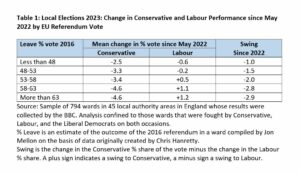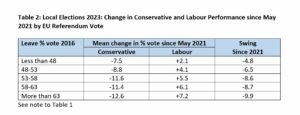Previously we have examined the extent to which the relationship between attitudes towards Brexit and party support has changed since 2019, when most Leave voters backed the Conservatives and most Remain supporters did not. We noted that support for the Conservatives has collapsed among those who voted Leave in 2016, while support for Labour has increased somewhat more among Leave voters than Remain supporters. As a result, there has been a marked weakening of the relationship between Brexit outlook and party choice. That said, the weakening looks less marked if we look at current attitudes towards Brexit rather than how people said they voted seven years ago. Since 2019 some voters have brought their attitude towards Brexit into line with that of the party they support. At the same time, some of those who have changed the party they support have changed their attitude towards Brexit too.
Still, under Britain’s first-past-the-post electoral system what matters to the parties is not just who is supporting them, but where they reside. Labour, in particular, are confronted with an adverse electoral geography that, unless changed, could require the party to secure as much as a twelve-point lead over the Conservatives just to secure an overall majority of one. Meanwhile, the Conservative seats that Labour are best placed to capture in their quest for a majority are ones that voted more heavily for Leave (the average level of support for exiting the EU was 55.8% in these seats) than the country as a whole. So doing particularly well in Leave-voting areas would open up the prospect for Labour of improving the geography of its support and thus its chances of winning a majority at the next election.
The local elections that took place in much of England outside London on May 5 provide us with a particularly valuable opportunity to assess whether Leave voting places are swinging strongly from Conservative to Labour. There was already reason to believe they were. In particular, the results of last year’s local elections indicated that, in general, the swing from Conservative to Labour since the preceding local elections (that is, May 2021) had been rather stronger in Leave voting areas. However, prior to 2021 the Conservatives had been advancing more strongly in Leave voting areas, in line with what had happened in the 2019 general election, and the movement in the opposite direction between 2021 and 2022 only represented a partial reversal of that pattern.
This year’s local elections did witness a further continuation of the pattern evident in last year’s local elections. As Table 1 shows, support for the Conservatives fell somewhat more heavily in those wards that voted most strongly for Leave in 2016 than it did in those that were less supportive of Brexit. Meanwhile Labour’s vote edged up a little in the most pro-Leave wards while slipping back slightly in the least pro-Leave. In combination these patterns ensured that the swing to Labour since last year was some two points higher in the most strongly pro-Leave wards than in the least strongly ones.
As we might therefore anticipate, and is shown in Table 2, this means there is an even sharper difference between the swing since 2021 in heavily pro-Leave areas and that in places where Brexit was less popular. The fall in Conservative support since May 2021 (when the party was still ahead of Labour in the national opinion polls) is on average five points higher in the most pro-Leave wards than in the least pro-Leave, while the increase in Labour support is five points higher in the most pro-Leave wards. This five-point figure is the product of the two-point difference this year (see Table 1) and a three-point one last year.


